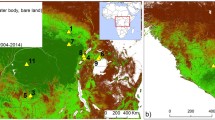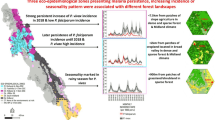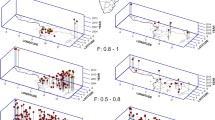Abstract
Land use change near dense forests is the single major cause of emergence of forest-based emerging infectious diseases (EIDs) among humans. In an attempt to predict where the next EID would originate from, we are hypothesizing that future EIDs would originate from a region having high population density, excessive poverty, and is located near dense vegetation. Using ArcGIS, we identified forest regions in ten countries across the globe that meet all the three conditions identified in the hypothesis. We further narrowed down the locations using Global Forest Watch data, which eliminates locations next to protected forests and fragmented forests. Our results indicate that there is high likelihood of next infectious disease originating from the southern and eastern forests around Freetown in Sierra Leone, the forest region around Douala in Cameroon, or the southern forest region in Nigeria. Concerted efforts need to be made to identify any new disease in the areas as soon as it emerges in the human population and contain the spread within the population.






Similar content being viewed by others
References
Camara, M., Kaba, D., KagbaDouno, M., Sanon, J. R., Ouendeno, F. F., & Solano, P. (2004). Human African trypanosomiasis in the mangrove forest in Guinea: epidemiological and clinical features in two adjacent outbreak areas. Medecine Tropicale: Revue du Corps de Sante Colonial, 65(2), 155–161.
Chomel, B. B., Belotto, A., & Meslin, F. X. (2007). Wildlife, exotic pets, and emerging zoonoses. Emerging Infectious Diseases, 13(1), 6–11.
DeFries, R. S., Rudel, T., Uriarte, M., & Hansen, M. (2010). Deforestation driven by urban population growth and agricultural trade in the twenty-first century. Nature Geoscience, 3(3), 178–181.
Despommier, D., Ellis, B. R., & Wilcox, B. A. (2006). The role of ecotones in emerging infectious diseases. EcoHealth, 3(4), 281–289.
Fidler, D. P. (1996). Globalization, international law, and emerging infectious diseases. Emerging Infectious Diseases, 2(2), 77–84.
Galindo, P., Trapido, H., & Carpenter, S. J. (1950). Observations on diurnal forest mosquitoes in relation to sylvan yellow fever in Panama. American Journal of Tropical Medicine, 30(4), 533–574.
Goldberg, T. L., Gillespie, T. R., Rwego, I. B., Estoff, E. L., & Chapman, C. A. (2008). Forest fragmentation as cause of bacterial transmission among nonhuman primates, humans, and livestock, Uganda. Emerging Infectious Diseases, 14(9), 1375–1382.
Harris, M., & Reza, J. N. (2012). Global report for research on infectious diseases of poverty. Geneva: World Health Organization.
Kale, Y. (2012). The Nigeria poverty profile 2010 report. Press Briefing By The Statistician-General.
Leone, S. S. (2013). A poverty profile for Sierra Leone. World.
Lindahl, J. F., & Grace, D. (2015). The consequences of human actions on risks for infectious diseases: a review. Infection Ecology & Epidemiology, 5(1), 30048.
McMichael, A. J. (2004). Environmental and social influences on emerging infectious diseases: past, present and future. Philosophical Transactions of the Royal Society of London. Series B, Biological Sciences, 359, 1049–1058.
Meentemeyer, R. K., Haas, S. E., & Václavík, T. (2012). Landscape epidemiology of emerging infectious diseases in natural and human-altered ecosystems. Annual Review of Phytopathology, 50, 379–402.
Meyer, W. B., & Turner, B. L. (1992). Human population growth and global land-use/cover change. Annual Review of Ecology and Systematics, 23, 39–61.
Morens, D. M., & Fauci, A. S. (2013). Emerging infectious diseases: threats to human health and global stability. PLoS Pathogens, 9(7), e1003467.
Patz, J. A., Graczyk, T. K., Geller, N., & Vittor, A. Y. (2000). Effects of environmental change on emerging parasitic diseases. International Journal for Parasitology, 30(12), 1395–1405.
Patz, J. A., Daszak, P., Tabor, G. M., Aguirre, A. A., Pearl, M., Epstein, J., … & Bradley, D. J. (2004). Unhealthy landscapes: policy recommendations on land use change and infectious disease emergence. Environmental Health Perspectives, 112(10), 1092–1098.
Rebaudet, S., Sudre, B., Faucher, B., & Piarroux, R. (2013). Cholera in coastal Africa: a systematic review of its heterogeneous environmental determinants. Journal of Infectious Diseases, 208(suppl 1), S98–S106.
Satterthwaite, D. (2004). The under-estimation of urban poverty in low and middle-income nations (Vol. 14). IIED.
Vythilingam, I. (2010). Review paper Plasmodium knowlesi in humans: a review on the role of its vectors in Malaysia. Tropical Biomedicine, 27(1), 1–12.
Webcitation 1: www.arcgis.com/home/item.html?id=07820fa6b81e4b2b996c394bf76d63ea
Webcitation 2: www.arcgis.com/home/item.html?id=a78894720c984694a1673bc9c3702d82
Webcitation 3: http://tiles.arcgis.com/tiles/P8Cok4qAP1sTVE59/arcgis/rest/services/Daily_income/MapServer
Webcitation 4: www.globalforestwatch.org
Wilcox, B. A., & Ellis, B. (2006). Forests and emerging infectious diseases of humans. UNASYLVA-FAO, 57(2), 11.
Wolfe, N. D., Daszak, P., Kilpatrick, A. M., & Burke, D. S. (2005). Bushmeat hunting, deforestation, and prediction of zoonotic disease. Emerging Infectious Diseases, 11(12), 1822–1827.
Author information
Authors and Affiliations
Corresponding author
Rights and permissions
About this article
Cite this article
Shah, V., Shah, A. & Joshi, V. Predicting the origins of next forest-based emerging infectious disease. Environ Monit Assess 190, 337 (2018). https://doi.org/10.1007/s10661-018-6711-6
Received:
Accepted:
Published:
DOI: https://doi.org/10.1007/s10661-018-6711-6




